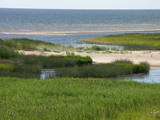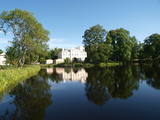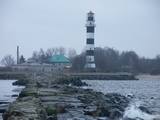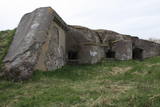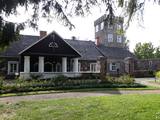| Nr | Nosaukums | Apraksts |
|---|---|---|
|
Ziemeļaustrumos no Mazirbes baznīcas, - starp dievnamu un Pakalnu mājām laukā redzami divi mēra akmeņi. Uz lielākā virsmas bijis (šobrīd izdzisis) teksts par lībiešiem, kurus pieveicis Zviedrijas karalis Kārlis IX un mēris. Pie lielākā akmens sāna atbalstīts otrs (vismazākais) mēra akmens, kas savulaik atradies pie Pakalnu mājām. Izdzisušais teksts stāstījis par armijām, kas staigājušas pa Kurzemi, badu un mēri. Trešais – Lielais mēra akmens atrodas aiz Mazirbes mācītājmuižas. Tajā iekaltais teksts (nedaudz saskatāms) ir vēstījums nākamajām paaudzēm par vietējo mācītāju (mira no mēra) un pastorāta izveidi Sīkragā. Vienlaikus tas ir arī piemineklis sešiem plašākas apkārtnes draudzes mācītājiem. Visi trīs mēra akmeņi „stāsta” par 1710. gada Lielo mēri un teksti tajos iegravēti laikā no 1711. - 1734. gadam. |
||
|
„Ainaži – Salacgrīva” - nozīmīga teritorija rifu aizsardzībai. Teritorija atrodas iepretim Salacgrīvas novadam, tās platība ir 7239 ha.
|
||
|
Iespaidīgākā un krāšņākā smilšakmens klinšu grupa
Vidzemes piekrastē. Viļņi te ir izveidojuši līdz 6 m augstu stāvkrastu, kur
vairāku simtu metru garumā atsedzas sarkanas smilšakmens klintis ar
seklām abrāzijas alām, nišām, grotām un citiem veidojumiem. Netālu
atrodas Veczemu saimniecība, kur Rīgas kinostudija uzņēmusi „Ilgo ceļu
kāpās” un „Veco jūrnieka ligzdu”.
|
||
|
Restorāns "Martinelli" atrodas Talsu centrā, Lielās ielas malā. Piedāvā ēdienus no vecmāmiņu pavārgrāmatas, pasaules virtuvi un plašu vīna klāstu. Sadarbojas ar vietējiem zemniekiem. Latviešu virtuve: Skābu kāpostu zupa ar ceptu cūkgaļas krūtiņu, meža sēņu – grūbu zupa, siļķe ar biezpienu, bukstiņputra, šmorcepetis ar šķovētiem kāpostiem, jēra cepetis, biezpiena plācenīši, Latvijā ražotas alus šķirnes. |
||
|
Kafejnīca "Magdalēna" atrodas Saldus pilsētas centrā. Latviešu virtuve: skābu kāpostu, frikadeļu, biešu, skābeņu un aukstā kefīra zupa, kartupeļu pankūkas, plānās pankūkas, šmorētas cūkgaļas ribiņas, mājas kotletes, Zemnieku cienasts, auzu pārslu krēms, auzu pārslu kārtojums, rupjmaizes kārtojums. |
||
|
Atrodas Daugavas labajā krastā pie Karikstes upītes ietekas Daugavā. Pili, no kuras mūsdienās ir saglabājusies tikai sienas drupas un pamati, Livonijas ordenis uzcēla 1224. gadā. To apdzīvoja līdz 17. gs. vidum, kad Poļu - zviedru kara laikā celtni sagrāva. Uz pilsdrupām paveras labs skats no ceļa (grantēts), kas aizlokas lejup pa Daugavas ielejas labo krastu. |
||
|
Igates pils atrodas skaistā vietā, Igatē, 15 minūšu braucienā no Limbažiem un mazliet vairāk kā stundas braucienā no galvaspilsētas Rīgas. Pils teritoriju ieskauj dīķis un iekopts parks nesteidzīgām pastaigām. Komplekss pieejams svētkiem pilī un atpūtai brīvdienu mājā. Teritorijā ir arī Igates Dzirnavu krodziņš. |
||
|
Amatnieka darbiem raksturīgas lakoniskas formas, atturīgs rotājums un tie pielietojami praktiskām ikdienas vajadzībām. Ekskursija pa darbnīcu, cepļa apskate, demonstrācijas un iespēja darboties ar mālu pašiem. Gatavo darbu iegāde, bišu dravas apskate, medus degustācija un iegāde. |
||
|
Pirmās bākas celtniecību pabeidza 1879. g. Bāka cietusi abos pasaules karos un vairakkārt atjaunota. Ēkas augstums - 19 m, bet pieskaitot stāvo, viļņu skaloto kāpu – 46,5 m. No Užavas bākas paveras viens no skaistākajiem Baltijas jūras krasta skatiem.
|
||
|
Kaunas Castle is the oldest stone castle in Lithuania and interestingly enough, the museum that is inside is also the oldest one in Lithuania. It's possible to take a tour to get know more about Kaunas Castle and also visit the museum where there's not only information about the castle but also about the city of Kaunas itself and much more. |
||
|
Spriņģu pilskalns (Golberova gora) atrodas Rēzeknes pilsētas
pievārtē un interesants ar savu īpatnējo veidolu. Valsts nozīmes arheoloģijas
piemineklis.
|
||
|
Viesu nams "Stikāni" atrodas 2km no Nagļiem, pašā Orenīšu dīķu krastā. Viesu namā atrodas 4 labiekārtoti, komfortabli divvietīgi numuriņi un ēdamistaba ar izeju uz dārza terasi. Viesi var pasūtīt ēdināšanas pakalpojumus vai arī gatavot paši - virtuvē ir viss nepieciešamais aprīkojums. Blakus ēkā atrodas dabas tūrisma informācijas centrs, kurā ceļotāji var pieteikties putnu vērošanas ekskursijām tuvējā apkaimē. Mājai piederošajā teritorijā ir izveidota dabas taka, kurā zinoša gida pavadībā iespējams iepazīt Latvijai raksturīgos kokus un krūmus, populārus un mazāk zināmus ārstniecības augus un lielu daļu pie mums ligzdojošo putnu (vasarā) vai arī vērot iespaidīgu putnu migrāciju pavasaros un rudeņos. Dārzā putnus var vērot arī no speciāla slēpņa. |
||
|
Rietumu mols (pabeigts 1885. g.) iestiepjas jūrā 860 m garumā un kopā ar Austrumu molu regulē Daugavas ieteci jūrā, mazinot tās aizsērēšanu. Mola hidrotehniskās būves pamatā ir pāļu konstrukcija, kas stiprināta ar akmeņiem. Tas vairākkārt rekonstruēts un nostiprināts. 19. gs. uz mola atradies katordznieku cietums. Apmēram ½ no mola ir atjaunota, to nobetonējot. Pārējā daļa šobrīd ir diezgan bēdīgā stāvoklī! Jau 1528. g. Poļu karalis Stefans Batorijs izdeva pavēli par bākas būvniecību Daugavas grīvā. Pirmā karte, kurā attēlota bāka, datēta ar 1536. gadu. 1721. g. Krievijas bāku uzskaitē minēts, ka šeit atrodas akmeņu krāvums, uz kura dedzināta uguns. Vēlāk celti koka un akmens torņi, kas karu laikā iznīcināti. Pašreizējā Daugavgrīvas bāka celta 1957. g. un ir 35 m augsta. Tās uguns redzama 18 jūras jūdžu tālumā. |
||
|
Bez jau šajā datu bāzē pieminētajiem Liepājas Ziemeļu fortiem, krasta baterejām un Karostas, Liepājas pilsētas perimetrā atrodas arī citi un iespaidīgi šīs sistēmas elementi, no kuriem, esot Liepājā, būtu vērts apskatīt Luneti (Tosmares ezera dienviddaļa), Vidusfortu (starp Grīzupes ielu un 14. Novembra bulvāri), Austrumu fortu (dienvidos no Brīvības ielas un ziemeļos no Liepājas ezera), Dienvidu fortu (pie Pērkones kanāla) un Vecos fortus pie stadiona „Olimpija”. Visas minētās vietas ir brīvi pieejamas, taču jāievēro piesardzības pasākumi to apskates laikā, jo savulaik saspridzinātie forti var būt bīstami apmeklējumiem no iekšpuses.
|
||
|
Starp steķiem un Tūjas ķieģeļu fabriku bija
izveidots sliežu ceļš, pa kuru transportēja labākās kvalitātes ķieģeļus.
Pēckara gados „Dzeņu” krastā uzcēla zivju pārstrādes rūpnīcu, bet pāri
steķiem – cauruli, pa kuru ar ventilatora palīdzību sūknēja zivis no kuģiem,
kas bija piestājuši steķu galā.
|
||
|
Burbišķes muižā 1991. gadā ierīkots Daugivenes kultūras vēstures muzejs – liegums aizņem 28 ha platību. Centrālajā parka daļā ir 3 ha dīķis ar 15 salām, 11 tiltiem un tiltiņiem. Kopš 2000. gada te tiek organizēti tulpju ziedēšanas svētki, kuru laikā tiek eksponētas ap 300 šķirņu tulpes. |
||
|
Taka ap Ozolu Mazezeru. Purvaino krastu posmā, ap ezera rietumu galu, ierīkotas gājēju laipas. Novērojami purva, meža un ezera augi, dzīvnieki un biotopi. Jūlija beigās īpaši krāšņi zied ūdensrozes. Blakus atrodas Ozolmuiža ar parku.
|
||
|
Restorāns "Rozālija" atrodas Rēzeknes centrā – viesnīcas "KOLONNA Hotel Rēzekne" telpās. No vasaras terases skats uz Rēzeknes upītes krasta promenādi. Viesiem piedāvā pēc senām latgaliešu receptēm gatavotus ēdienus. Izmanto vietējo ražotāju produktus. Latviešu virtuve: cepta siļķe, skābu kāpostu zupa, gulbešnīki, cūkgaļas un kartupeļu (buļbas) ēdieni, kļockas, asuškas ar krējumu un šmakovka. Īpašais ēdiens: kartupeļu klimpas ar nātru eļļu un gaļas veltnītis. |
||
|
Formu ziņā viens no daudzveidīgākajiem Latvijas smilšakmens atsegumiem, kas ieslēpies Gaujas labā pamatkrasta nogāzē, sasniedzot 15 m augstumu. Atsegumu „sacaurumojušas” vientuļās bites (aizsargājamas), kas smilšakmeņos veido mazas aliņas, kurās attīstās kāpuri. Izveidota lokveida labiekārtota taka ar kāpnēm. Ietilpst Gaujas nacionālajā parkā.
|
||
|
Saimniece gardēžu grupām piedāvā līdzdarboties dažādās kulinārijas darbnīcās (2 – 3 stundas): „Saldo kukšu darbnīcā”, „Netradicionālo sezonas dārzeņu ēdienu darbnīcā”, „Picu darbnīcā”, “Kaņepju staka gatavošana" u.c. Tiem, kas paši nevēlas gatavot, tiek piedāvāts nesteidzīgs lauku mielasts apvienojumā ar saimniecības, vīnogu dārza apskati un sarunām par dzīvi laukos. |
||

